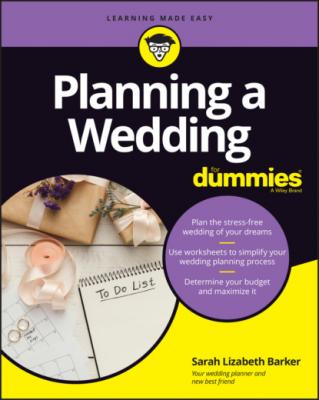Planning A Wedding For Dummies. Sarah Lizabeth Barker
Чтение книги онлайн.
Читать онлайн книгу Planning A Wedding For Dummies - Sarah Lizabeth Barker страница 24
 Officiant, flowers, decor, guest book, etc.
Officiant, flowers, decor, guest book, etc.
Resourcing your connections
Let’s talk about who you know. Is there anyone in your life who provides a service that you need for your wedding? Resourcing your connections can help you save money on your budget. If someone provides a service you need (not a product), you may even eliminate the financial obligation if they donate the service to you for your wedding day.
In the next chapter, we’ll discuss picking your perfect team. Using your connections can be very valuable in saving money for your wedding. However, sometimes, you get what you pay for. We’ll spend time discussing that soon, but for now, if it’s an important item on your list, make sure you’re using a pro. For an item that isn’t as important, this is an area where you can save.
Regarding flowers and decor, hit up the local buy-sell trade. After a wedding, couples often sell the items they don’t need anymore. It’s a resource to purchase linens, candles, and table decor. My only caution about this is that you need to make sure it’s worth the savings. If all the candles are already almost burned fully, there’s no need to purchase those. If the linens are stained and in bad shape, then try renting those through your rental company.
Mostly, be resourceful if you need to save money on your budget. It’s easy to fall in love with a vendor online and then find out there’s no way you can possibly afford them. I don’t want that for you, so determine your budget, figure out what’s most important to you, start plugging in those numbers, and then get resourceful!
Setting limits
The biggest budget buster is not setting limits on your guest list and budget. It’s important to make sure you have determined how much you can spend so that you avoid scrambling in the end, trying to come up with money you simply don’t have.
Your budget is often determined by how many guests you’re having at your wedding. Whether you have 50 guests or 200 guests, your budget will have to include everything you need to put on the size of a wedding that you planned. When you tell a vendor you’ll have 100 guests and you end up with 150 guests, that will be a big budget buster.
When I’m discussing a guest list with a client, I often say to them, “Can you hand each person on this list $200, and say, I want you to come to my wedding?” It’s easy to get caught up in who should and should not be invited. It’s a train that you can’t stop. You invite one person, then you must invite another person, then another, and another, and all of a sudden, you have 50 people on the invite list who really shouldn’t be.
I always encourage my clients to divide the list between their parents’ friends and their friends. It can be frustrating to feel like you need to invite someone because they’re friends of the family. You don’t really know them but now you must pay for them to come to your wedding. Set those limits early in the planning process. Consider your friends being 50% of the list and then divide the remaining 50% between both sets of parents. Make sure those limits are set and stick to it to avoid additional costs that weren’t originally factored into your budget.
Buyer beware: Service fees
There is a very important fee you should be aware of. Often, this fee goes unnoticed until the final bill. When you’re aware of it, the vendor may have whispered it or maybe said it in the middle of a cough. It’s what I call the “Service ++ Fee.” Often, you won’t know what the “++” is. Is it 5% or 50%? Because we don’t know, it’s very important to talk with your vendors about it. Each state has different rules and regulations on food and alcohol tax. It’s important to find out what yours is in the location where you’re hosting your wedding.
I also had a client who had a friend read a scripture at their wedding. The friend saw a podium sitting over in the corner of the room and pulled the podium over so that she could place her reading in front of her. Well, after the wedding, the client got a final bill with a $250 service fee. When she inquired about this mysterious charge, the ceremony location said it was for the use of the podium. You know, the one that her friend moved over by herself? Now the client had to pay for a podium she didn’t even want.